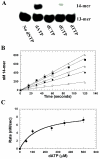Mechanism and dynamics of translesion DNA synthesis catalyzed by the Escherichia coli Klenow fragment
- PMID: 18652487
- PMCID: PMC2692461
- DOI: 10.1021/bi800324r
Mechanism and dynamics of translesion DNA synthesis catalyzed by the Escherichia coli Klenow fragment
Abstract
Translesion DNA synthesis represents the ability of a DNA polymerase to incorporate and extend beyond damaged DNA. In this report, the mechanism and dynamics by which the Escherichia coli Klenow fragment performs translesion DNA synthesis during the misreplication of an abasic site were investigated using a series of natural and non-natural nucleotides. Like most other high-fidelity DNA polymerases, the Klenow fragment follows the "A-rule" of translesion DNA synthesis by preferentially incorporating dATP opposite the noninstructional lesion. However, several 5-substituted indolyl nucleotides lacking classical hydrogen-bonding groups are incorporated approximately 100-fold more efficiently than the natural nucleotide. In general, analogues that contain large substituent groups in conjunction with significant pi-electron density display the highest catalytic efficiencies ( k cat/ K m) for incorporation. While the measured K m values depend upon the size and pi-electron density of the incoming nucleotide, k cat values are surprisingly independent of both biophysical features. As expected, the efficiency by which these non-natural nucleotides are incorporated opposite templating nucleobases is significantly reduced. This reduction reflects minimal increases in K m values coupled with large decreases in k cat values. The kinetic data obtained with the Klenow fragment are compared to that of the high-fidelity bacteriophage T4 DNA polymerase and reveal distinct differences in the dynamics by which these non-natural nucleotides are incorporated opposite an abasic site. These biophysical differences argue against a unified mechanism of translesion DNA synthesis and suggest that polymerases employ different catalytic strategies during the misreplication of damaged DNA.
Figures






References
-
- Knowles JR. Enzyme-catalyzed phosphoryl transfer reactions. Annu. Rev. Biochem. 1980;49:877–919. - PubMed
-
- Kunkel TA, Bebenek K. DNA replication fidelity. Annu. Rev. Biochem. 2000;69:497–529. - PubMed
-
- Johnson KA. Conformational coupling in DNA polymerase fidelity. Annu. Rev. Biochem. 1993;62:685–713. - PubMed
-
- Beckman RA, Loeb LA. Multi-stage proofreading in DNA replication. Q. Rev. Biophys. 1993;26:225–331. - PubMed
Publication types
MeSH terms
Substances
Grants and funding
LinkOut - more resources
Full Text Sources
Research Materials
Miscellaneous

